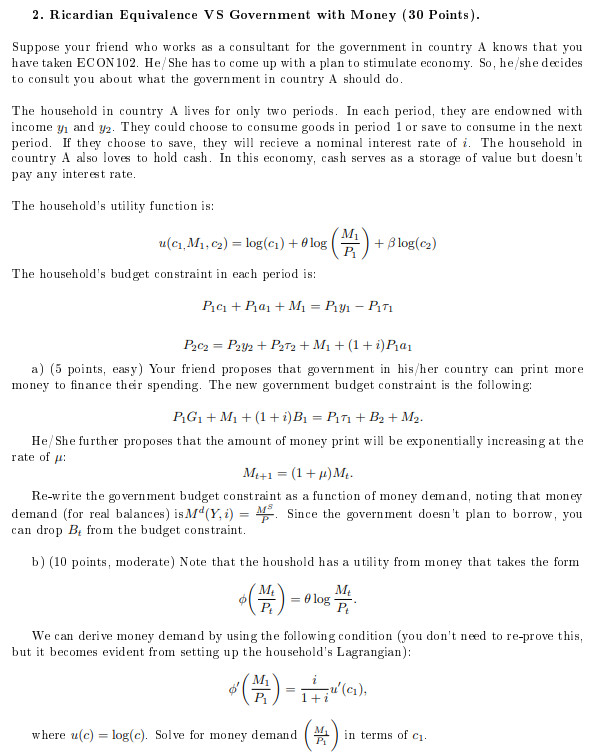
2. Ricardian Equivalence VS Government with Money (30 Points). Suppose your friend who works as a consultant for the government in country A knows that you have taken ECON102. He/She has to come up with a plan to stimulate economy. So, he/she decides to consult you about what the government in country A should do. The household in country A lives for only two periods. In each period, they are endowned with income y1 and y2. They could choose to consume goods in period 1 or save to consume in the next period. If they choose to save, they will recieve a nominal interest rate of i. The household in country A also loves to hold cash. In this economy, cash serves as a storage of value but doesn't pay any interest rate. The household's utility function is: u(c1,M1,c2)=log(c1)+log(P1M1)+log(c2) The household's budget constraint in each period is: P1c1+P1a1+M1=P1y1P11P2c2=P2y2+P22+M1+(1+i)P1a1 a) (5 points, easy) Your friend proposes that government in his/her country can print more money to finance their spending. The new government budget constraint is the following: P1G1+M1+(1+i)B1=P11+B2+M2. He/She further proposes that the amount of money print will be exponentially increasing at the rate of : Mt+1=(1+)Mt. Re-write the government budget constraint as a function of money demand, noting that money demand (for real balances) is Md(Y,i)=PMS. Since the government doesn't plan to borrow, you can drop Bt from the budget constraint. b) (10 points, moderate) Note that the houshold has a utility from money that takes the form (PtMt)=logPtMt. We can derive money demand by using the following condition (you don't need to re-prove this, but it becomes evident from setting up the household's Lagrangian ): (P1M1)=1+iiu(c1), where u(c)=log(c). Solve for money demand (P1M1) in terms of c1. 2. Ricardian Equivalence VS Government with Money (30 Points). Suppose your friend who works as a consultant for the government in country A knows that you have taken ECON102. He/She has to come up with a plan to stimulate economy. So, he/she decides to consult you about what the government in country A should do. The household in country A lives for only two periods. In each period, they are endowned with income y1 and y2. They could choose to consume goods in period 1 or save to consume in the next period. If they choose to save, they will recieve a nominal interest rate of i. The household in country A also loves to hold cash. In this economy, cash serves as a storage of value but doesn't pay any interest rate. The household's utility function is: u(c1,M1,c2)=log(c1)+log(P1M1)+log(c2) The household's budget constraint in each period is: P1c1+P1a1+M1=P1y1P11P2c2=P2y2+P22+M1+(1+i)P1a1 a) (5 points, easy) Your friend proposes that government in his/her country can print more money to finance their spending. The new government budget constraint is the following: P1G1+M1+(1+i)B1=P11+B2+M2. He/She further proposes that the amount of money print will be exponentially increasing at the rate of : Mt+1=(1+)Mt. Re-write the government budget constraint as a function of money demand, noting that money demand (for real balances) is Md(Y,i)=PMS. Since the government doesn't plan to borrow, you can drop Bt from the budget constraint. b) (10 points, moderate) Note that the houshold has a utility from money that takes the form (PtMt)=logPtMt. We can derive money demand by using the following condition (you don't need to re-prove this, but it becomes evident from setting up the household's Lagrangian ): (P1M1)=1+iiu(c1), where u(c)=log(c). Solve for money demand (P1M1) in terms of c1







